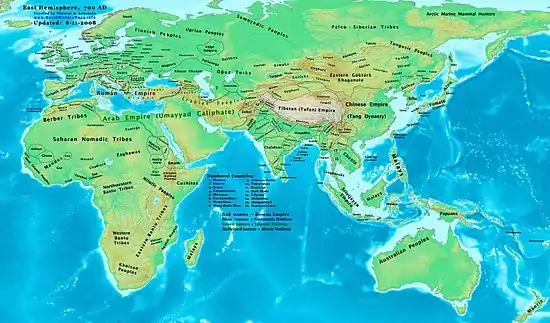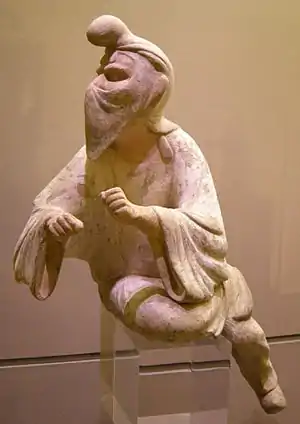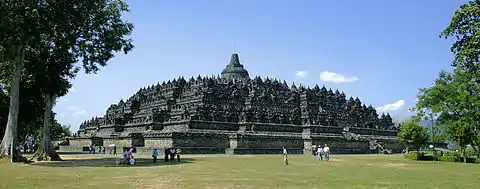8th century
The 8th century is the period from 701 through 800 in accordance with the Julian Calendar. The coast of North Africa and the Iberian Peninsula quickly came under Islamic Arab domination. The westward expansion of the Umayyad Empire was famously halted at the Siege of Constantinople by the Byzantine Empire and the Battle of Tours by the Franks. The tide of Arab conquest came to an end in the middle of the 8th century.[1]
| Millennium: | 1st millennium |
|---|---|
| Centuries: | |
| Timelines: | |
| State leaders: | |
| Decades: | |
| Categories: | Births – Deaths Establishments – Disestablishments |

In Europe, late in the century, the Vikings, seafaring peoples from Scandinavia, begin raiding the coasts of Europe and the Mediterranean, and go on to found several important kingdoms.
In Asia, the Pala Empire is founded in Bengal. The Tang dynasty reaches its pinnacle under Chinese Emperor Xuanzong. The Nara period begins in Japan.
Events
- Estimated century in which the poem Beowulf is composed.
- Classical Maya civilization begins to decline.
- The first Serbian state is formed at the beginning of the century.
- Buddhist Jataka stories are translated into Syriac and Arabic as Kalilag and Damnag.
- An account of Buddha's life is translated into Greek by Saint John of Damascus, and widely circulated to Christians as the story of Barlaam and Josaphat.
- Height of the Classic period in pre-Columbian Maya civilization history.
- Śāntideva, a Buddhist monk at Nalanda Monastery in India, composes the famous Bodhicharyāvatāra, or Guide to the Bodhisattva's Way of Life.
- The height of the Giant Wild Goose Pagoda in Xian, China is extended by 5 stories.
- 701: The Taihō Code is enacted in late Asuka period Japan.
- 705: Overthrow of Empress Wu Zetian, the reign of China's first and only sole-ruling empress ends.
- 705: Justinian II is forced to give the title Caesar of Byzantium to the Bulgarian Emperor Tervel. The Byzantine Empire begins to pay annual tributes to Bulgaria.
- 708 – 711: The Bulgarians defeat Justinian II at the battle of Anchiallus. Arab armies occupied Sindh.[2]
- 710: Empress Genmei moves the capital to Heijō-kyū (present day Nara), initiating the Nara period of Japan.
- 711: Palenque is conquered by Toniná.
- 711: Tariq ibn Ziyad crosses the Straits of Gibraltar.[2] With the creation of Al-Andalus, most of the Iberian Peninsula is conquered by Arab and Berber Muslims, thus ending the Visigothic rule, and beginning almost eight centuries of Muslim rule.
- 712: Liutprand, King of the Lombards begins his reign (until 744).
- c. 712: Metropolitan episcopal see is established by the Church of the East in Chinese capital of Chang'an.
- 712 – 756: Emperor Xuanzong reigned, the time was considered one of China's high points.
- 712 – 740: Caliphate campaigns in India
- 713: Death of Dajian Huineng, sixth and last Patriarch of Chán Buddhism.
- 713 - Treaty of Tudmir, signed between Abd al-'Aziz, the commander of Muslim troops invaidibng Spain and Theodemir, the Christian king of a southern region is Spain.
- 717 – 718: Siege of Constantinople. The Bulgarians and the Byzantines decisively defeat the invading Arabs, thus halting the Arab advance toward Europe.
- 718: Sri Indravarman King of Srivijaya send a letter to the Caliph Umar bin Abdul Aziz of the Umayyad Caliphate in Damascus, signing early ancient Indonesian official contact with Islamic world in the Middle East.[3]
- 726: Byzantine Emperor Leo III the Isaurian destroys the icon of Christ above the Chalke Gate in the capital city of Constantinople, beginning the first phase of the Byzantine Iconoclasm.
- 731: Bede completes his Historia ecclesiastica gentis Anglorum (Ecclesiastical History of the English People).[4]
- 732: Battle of Tours. Near Poitiers, France, leader of the Franks Charles Martel and his men defeat a large army of Moors under the governor of Cordoba, Abdul Rahman Al Ghafiqi, who is killed during the battle. The Battle of Tours halts the advance of Islam into Western Europe and establishes a balance of power between Western Europe, Islam and the Byzantine Empire.
- 732: The Sanjaya dynasty is founded around this time according to the Canggal inscription.[5]

- 738: Quiriguá declares independence from Copan
- 740: Battle of Akroinon. Byzantines win their first large-scale victory in a pitched battle against the Arabs.
- 742: For the municipal census of the Tang-dynasty Chinese capital city Chang'an and its metropolitan area of Jingzhou Fu (including small towns in the vicinity), the New Book of Tang records that in this year there were 362,921 registered families with 1,960,188 persons.
- 748: The Chinese Buddhist monk Jian Zhen writes in his Yue Jue Shu of the international sea traffic coming to Guangzhou, ships from Borneo, Persia, Sri Lanka, Indonesia, and others bringing tons of goods.
- 750: The last Umayyad Caliph Marwan II (744–750) is overthrown and executed by the first Abbasid Caliph, Abu al-Abbas al-Saffah. The Caliphate is moved to Baghdad which would later develop into a centre of trade and culture. The Ghana Empire begins in western Africa.
- mid-8th century - Great Wild Goose Pagoda at Ci'en Temple, Xi'an, Shanxi, is rebuilt.
- c. mid-8th century - Camel Carrying a Group of Musicians, from a tomb near Xi'an, Shanxi, is made. Tang dynasty. It is now kept at Museum of Chinese History, Beijing.
- 751: Arabian armies defeat Chinese Tang dynasty troops in the Battle of Talas, in the high Pamirs near Samarkand, and conquer Central Asia completely.
- 752: The Hindu Medang (Mataram) kingdom flourishes and declines.[7] (to 1045)
- 755 – 763: The An Shi Rebellion devastates China during the mid Tang dynasty.
- 757: King Offa of Mercia becomes dominant ruler in England.
- 758: Arab and Persian pirates and travelers burn and loot the Chinese city of Guangzhou, while the Tang Dynasty authorities shut the port down for the next five decades.
- 760: The construction of the famous Indonesian Buddhist structure Borobudur began, probably as a non-Buddhist shrine.[8]
- 768: Pepin dies; Charles becomes king at Noyan and his brother Carloman becomes king at Soissons.
- 770's – 780's: Java launched series of naval raids on ports of Dai Viet, Champa and Cambodia; Sontay in Tonkin (767); Nha Trang (774); captured Indrapura in Cambodia (770); Phan Rang (787). The naval raids was probably launched by Sailendran-Srivijayan Maharaja Dharmasetu or Dharanindra.[9]
- 772 – 804: Charlemagne invades what is now northwestern Germany, battling the Saxons for more than thirty years and finally crushing their rebellion, incorporating Saxony into the Frankish Empire and the Christian world.
- 778: Kalasan temple constructed, according to the Kalasan inscription.
- 781: Nestorian Monument is erected in China.
- 782: Buddhist monk Prajna reaches Chang'an and translates the sutras into Chinese.
- 785: The Tang dynasty begins landing regular maritime missions on the coast of East Africa, cutting out middlemen Arab sea merchants.
- 785 – 805: Chinese geographer Jia Dan describes large lighthouse pillars built in the Persian Gulf, which is confirmed a century later by al-Mas'udi and al-Muqaddasi.
- 787: The Empress Irene of Athens convenes the Seventh Ecumenical Council, ending the first phase of Byzantine Iconoclasm.
- 792: Battle of Marcelae. The Bulgarian victory over the Byzantines marks the end of the half-century political instability in Bulgaria.
- 792: The Manjusrigrha (Sewu) temple is completed according to Manjusrigrha inscription.
- 793: The first written account of a Viking raid carried out on the abbey of Lindisfarne in northern England.
- 793: The Frisian–Frankish wars come to an end with the last uprising of the Frisians.
- 794: Emperor Kanmu moves the capital to Heian-kyō (present day Kyoto), initiating the Heian period of Japan.
- 800: An Arab fleet sails up the Tiber.
- 800 – 909: Rule of Aghlabids as an independent Muslim dynasty in North Africa, with their capital at Tunis.
- 800: Beginning of the ancient West African state of Takrur or Tekrour, which flourished roughly parallel to the Ghana Empire.
- 800: On Christmas Day, Charlemagne is crowned the first Holy Roman Emperor by Pope Leo III.
- 800: The agriculturally based Buddhist Sailendra kingdom flourishes and declines.[5] (to 832)
Significant persons
Politics
- Abd al-Malik ibn Marwan, Umayyad Caliph from 685 to 705
- Abu Muslim, leader of the Abbasid Revolution
- Adrian I or Hadrian I, Pope from 772 to 795
- Charlemagne, King of the Franks from 771 to 814
- Charles Martel, Frankish leader until 741 (Battle of Tours, 732)
- Desiderius, last King of the Lombards from 756 to 774
- Dezong, Emperor of China from 779 to 805
- Genmei, Empress of Japan from 707 to 715
- Harun al-Rashid, fifth Abbasid Caliph from 786 to 809
- Hisham ibn Abd al-Malik, Umayyad Caliph from 723 to 743, during his reign the Caliphate reached its maximum expansion
- Irene of Athens, Byzantine Empress from 797 to 802
- K'ak' Joplaj Chan K'awiil 14th Ajaw of Copan
- K'ak' Yipyaj Chan K'awiil 749–763 15th Ajaw of Copan
- Kanmu, Emperor of Japan from 781 to 806
- Kōken, Empress of Japan from 749 to 758 and again with the name Shōtoku from 764 to 770
- Leo III the Isaurian, Byzantine Emperor from 717 to 741, repelled the Arabs and initiated Byzantine Iconoclasm
- Leo III, pope from 795 to 816
- Liutprand, King of the Lombards from 712 to 744
- al-Mansur, second Abbasid Caliph from 754 to 775, consolidated Abbasid power
- Paolo Lucio Anafesto, first doge of Venice from 697 to 717
- Pepin the Short, King of the Franks until 768
- Stephen II, Pope from 752 to 757, enlisted Frankish aid against the Lombards
- Tervel, Khan of Bulgaria from 700 to 721
- Uaxaclajuun Ub'aah K'awiil 695–738 13th Ajaw of Copan
- Umar bin Abdul Aziz, Caliph of Islamic Empire
- al-Walid ibn Abd al-Malik, Umayyad Caliph from 705 to 715
- Wu Zetian, Empress of China from 690 to 705
- Xuanzong, Emperor of China at height of Tang cultural influence from 712 to 756
- Yax Pasaj Chan Yopaat 763–after 810 16th Ajaw of Copan
Theology
- Adi Shankara, philosopher, theologian, and pioneer of Advaita Vedanta
- Alcuin, English monk, deacon, scholar, and teacher; Charlemagne's advisor in educational affairs
- Bede the Venerable, English monk and scholar
- Jianzhen or Ganjin, Chinese monk who helped to spread Buddhism in Japan
- John of Damascus, Syrian Christian monk, scholar
- Padmasambhava, Tantric master who created vajrayana buddhism in Tibet
- Timothy, Church of the East Patriarch of Baghdad, promoter of missions to China
- Paulinus II of Aquileia, Carolingian scholar, poet, patriarch of Aquileia from 787 to 802
- Vimalamitra, Buddhist monk from India
- Theodulf of Orléans, Carolingian scholar, poet, bishop of Orleans from 798 to 818
Military
- An Lushan, military leader of Sogdian and Tujue origin, led An Shi Rebellion from 755 to 763
- Guo Ziyi, who ended the An Shi Rebellion and was revered as the best general in East Asia during his lifetime.
- Muhammad bin Qasim, Arab general who conquered Sindh and Punjab
- Qutayba ibn Muslim, Muslim conqueror of Transoxania in 705-715
Literature
- Du Fu, Chinese poet
- Li Bai, Chinese poet
- Ragnar Lodbrok, possibly semi-legendary Norse viking (known only from the Icelandic sagas)
Visual Arts
Sciences and Philosophy
- Jia Dan, Chinese scholar-official, cartographer, and geographer
- Paul the Deacon, Lombard scholar, historian, poet
Inventions, discoveries, introductions

- Heavy plow in use in the Rhine valley.
- Horse collar in use in Northern Europe in 8th or 9th century — perhaps introduced from Asia.
- Mid 8th century – papermaking introduced from China to Arabs.
- Iron horseshoes came into common use around 770.
- Pattadakal, Chalukya architecture.
- The Chinese Buddhist monk Yi Xing applies a clockwork escapement mechanism to operate and rotate his astronomical celestial globe.
- The first European triangular harp designed by the Picts of Scotland.
References
- Roberts, J., History of the World, Penguin, 1994.
- Roberts, J., History of the World, Penguin, 1994.
- Azra, Azyumardi (2006). Islam in the Indonesian world: an account of institutional formation. Mizan Pustaka. ISBN 979-433-430-8.
- Palmer, Alan; Veronica (1992). The Chronology of British History. London: Century Ltd. pp. 34–37. ISBN 0-7126-5616-2.
- Miksic (1997)
- Lee Lawrence. (3 September 2011). "A Mysterious Stranger in China". The Wall Street Journal. Accessed on 31 August 2016.
- Miksic (2003)
- Taylor (2003), p. 37.
- Munoz, Paul Michel (2006). Early Kingdoms of the Indonesian Archipelago and the Malay Peninsula. Singapore: Editions Didier Millet. p. 171. ISBN 981-4155-67-5.
| Wikimedia Commons has media related to 8th century. |

